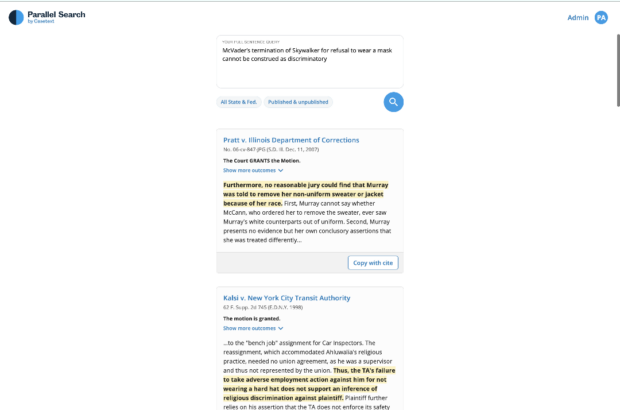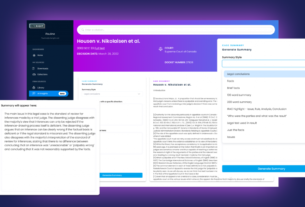Bringing Neural Nets to the Law
Casetext opened 2020 with the launch of a revolutionary new motion-drafting tool called Compose. Compose dramatically reduces the amount of time it takes lawyers to draft a motion or brief by serving up the arguments and standards appropriate to the motion type in a specific jurisdiction. Compose also included a powerful new search functionality called “Parallel Search,” which was the first legal research tool to leverage breakthrough technology called transformer-based neural nets. Parallel Search proved to be so popular with attorneys that in June of 2020 Casetext made that search capability available as a stand-alone product and an upgrade to their Casetext research platform. More than a decade ago, major legal research platforms Lexis and Westlaw freed their subscribers from Boolean search by introducing natural language search. But freedom from Boolean search did
amount of time it takes lawyers to draft a motion or brief by serving up the arguments and standards appropriate to the motion type in a specific jurisdiction. Compose also included a powerful new search functionality called “Parallel Search,” which was the first legal research tool to leverage breakthrough technology called transformer-based neural nets. Parallel Search proved to be so popular with attorneys that in June of 2020 Casetext made that search capability available as a stand-alone product and an upgrade to their Casetext research platform. More than a decade ago, major legal research platforms Lexis and Westlaw freed their subscribers from Boolean search by introducing natural language search. But freedom from Boolean search did
 amount of time it takes lawyers to draft a motion or brief by serving up the arguments and standards appropriate to the motion type in a specific jurisdiction. Compose also included a powerful new search functionality called “Parallel Search,” which was the first legal research tool to leverage breakthrough technology called transformer-based neural nets. Parallel Search proved to be so popular with attorneys that in June of 2020 Casetext made that search capability available as a stand-alone product and an upgrade to their Casetext research platform. More than a decade ago, major legal research platforms Lexis and Westlaw freed their subscribers from Boolean search by introducing natural language search. But freedom from Boolean search did
amount of time it takes lawyers to draft a motion or brief by serving up the arguments and standards appropriate to the motion type in a specific jurisdiction. Compose also included a powerful new search functionality called “Parallel Search,” which was the first legal research tool to leverage breakthrough technology called transformer-based neural nets. Parallel Search proved to be so popular with attorneys that in June of 2020 Casetext made that search capability available as a stand-alone product and an upgrade to their Casetext research platform. More than a decade ago, major legal research platforms Lexis and Westlaw freed their subscribers from Boolean search by introducing natural language search. But freedom from Boolean search didnot mean freedom from results limited to literal keyword matches. The concept-matching enabled by the neural net that powers Parallel Search is a a “great leap forward” and superior to anything enabled by earlier systems. Pablo Arredondo, co-founder and Chief Product Officer at Casetext, refers to traditional natural language search as “casual Friday in the prison of the keyword.” In other words, a lawyer was still at the mercy of which specific words he chose for his query.
I asked Arredondo to provide an example of how Parallel Search in action.
Consider this query: McVader’s termination of Skywalker for refusal to wear a mask cannot be construed as discriminatory.

Note that the query is actually a complete sentence, the type that might appear in a brief or memo. The returned cases include instances where an employee suffered adverse employment action for refusal to wear a hard hat, refusal to wear brazing goggles, and refusal to wear cut-resistant gloves. All of these are missed when you use traditional keyword search; instead you get some results about the word “refusal”, some about “mask”, some about “construed”… nothing that captures the concept.
“The breakthroughs in natural language processing that enable Parallel Search were developed/published at Google in late 2018/early 2019”, explained Arredondo. Prior to Parallel Search, all of Casetext’s products leveraged traditional keywords and the citation graph between cases. Although Casetext’s pioneering brief-analysis tool, CARA, went beyond a simple keyword query and instead leveraged an entire brief, it was still anchored in the specific words in that brief. To the extent CARA was able to return relevant results without keyword overlap, it was because the tool also leveraged the citation graph.
“When we decided to engage in the lengthy research and development to apply this type of neural net to legal research we were cognizant that the full-sentence-as-query granularity would complement CARA’s brief-as-query approach. But I wouldn’t call Parallel Search an evolution of CARA. Having said that, I am certain that a neural net-empowered version of CARA is possible, so perhaps CARA 2 will be an evolution of Parallel Search.”
Introducing WeSearch – Neural Networks on the Fly.
Over the past few months Casetext has been partnering with law firms around the country and enabling them to implement a quick-and-easy neural network solution to streamline research and profiling of documents for a variety of litigation and transactional tasks. They currently call this new offering WeSearch.
“There is a natural evolution between Parallel Search (neural nets applied to case law) and WeSearch (neural net applied to whatever documents the attorney uploads).” explained Arredondo, adding “we want to make it as easy for law firms to spin up neural nets as it is to grab a yellow legal pad from the drawer.”
WeSearch is being used in law firms for a variety transactional and litigation projects including:
· Creating brief banks
· Creating a Document Management System (DMS)
· Reviewing the entire archive of all litigation documents in a specific large litigation
· Internal internets
· E discovery projects including traditional document review and analysing archives of interrogatories to review for inconsistent answers
Arredondo provided an example of WeSearch at work in the context of e-discovery Using the Enron email corpus, a query for the phrase “I feel uneasy about this,” returns over a dozen conceptual matches in which no keyword overlap, including “This is unsettling.”; “That scares me a bit.” and “I am kinda uncomfortable with it.”

WeSearch is currently being piloted by select law firms. Casetext plans on expanding the offering to all current subscribers and new firms later this year. Interested firms should contact info@casetext.com.
NOTE: This post originally appeared on Above the Law.

